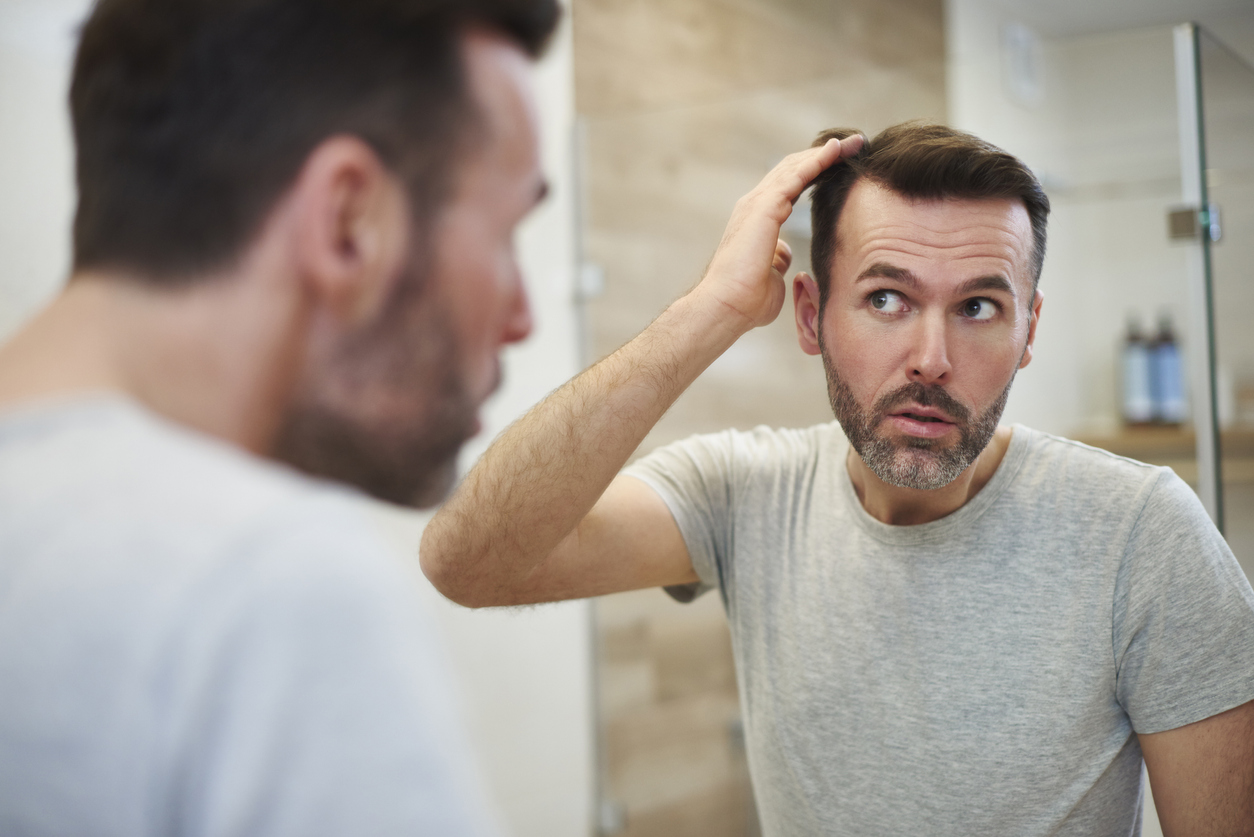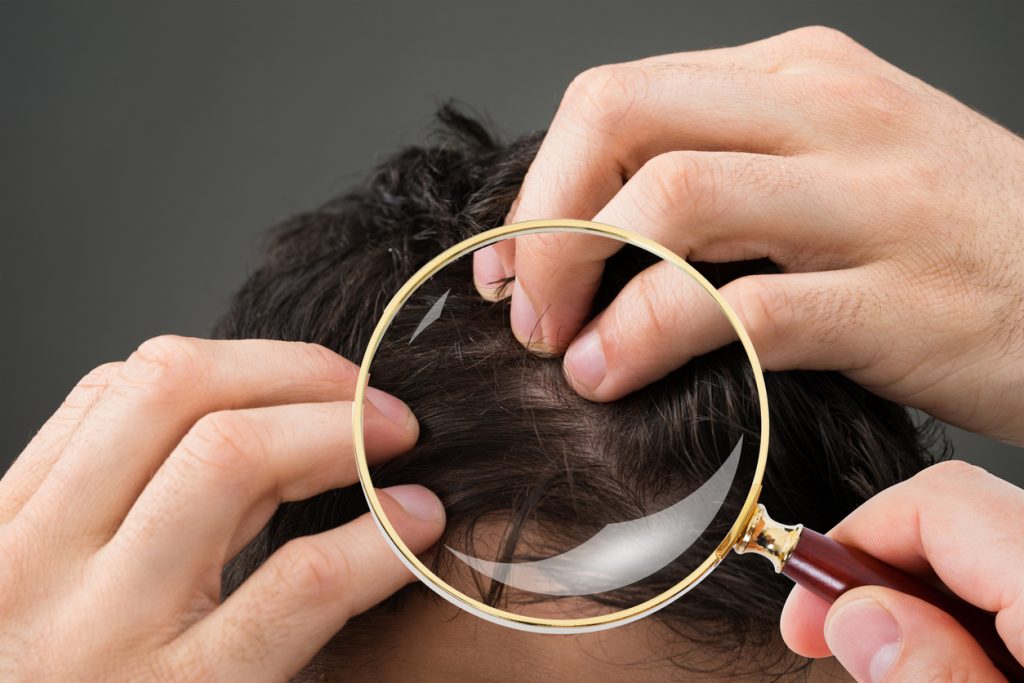
Hair loss: What you need to know about losing your hair and male pattern baldness
Discover the science of hair loss in men, male pattern baldness and what you can do to prevent – or treat – it
Hair loss may seem like something that affects older men but a quarter of us start going bald by the time we’re 30. Often if our Dad or Granddad went bald at a young age, we’ll notice the same bald patches at a similar age, but it’s not always the case.
There’s also a major difference between hair loss, and baldness.
For starters, male pattern baldness is a genetic condition that can’t be prevented. It typically starts with a receding hairline or a circular pattern of baldness on the crown of your head. Yet, if you’re losing your hair in patches, you may not actually be going bald. In this instance, there are things you can do to prevent hair loss.
We should point out that all men go bald. Eventually. You may not go bald until you’re in your 60s or 70s but at some point in your life, you will lose your hair either all over or in patches. It’s nothing to be embarrassed or ashamed of.
After having long hair and curtains at school – it was the 90s, haters gonna hate – we started losing our hair in our early 20s so we get it. We’ve been shaving ever since and have turned it into our statement look – we’ve owned our hair loss, rather than hid from it.
To help you understand a bit more about hair loss, its causes, and treatments, as well as male pattern baldness, we’ve taken a look at the science of hair below.
This is because knowing exactly how your hair grows means you know exactly what you need to do to help it grow faster, or prevent it from falling out, without spending a fortune on products and treatments.
FURTHER READING: Hair loss treatments for men UK
The science of hair
On average, your hair grows half a millimetre every day, which is about half an inch a month, or six inches a year. That’s according to the American Academy of Dermatology. If you have a short men’s hair style, it may seem like your hair grows faster than this but it could also just be because it’s more noticeable. Especially if the growth causes your once styled locks to go out of shape.
Your hair, itself, is made up of – protein, mainly a kind called keratin, natural oils to keep hair flexible, and water. It grows from the bottom of follicles in your scalp, called roots, and these consist of cell proteins.
The type of hair you have then depends on the shape of these follicles, and this is determined by your genetics.
- If your hair follicles are oval-shaped, you’ll have curly hair
- People with straight hair have circular follicles
The shape of your hair follicles also determines how thick your hair is, and how long it can grow. Blood vessels across your scalp help to produce these cells and your hair becomes visible once it’s long enough to pass through the oil gland, and your scalp’s skin.
However, by this point, your hair is dead – which is why it’s obviously not painful to have it cut. Treating the hair itself can make it softer or less matted but if you’re trying to prevent hair loss, you need to treat the scalp and the follicles first.
What causes hair loss?
 Getty Images/iStockphoto
Getty Images/iStockphoto
As your hair grows, it becomes heavier and pulls on the follicles. There comes a point when the weight of the hair is so strong that the follicle can’t hold onto it anymore and that particular strand falls out.
People with curly hair tend to “shed” hair more than people with straight and this is because scientific studies have found round follicles are stronger. Science suggests we lose 50 to 100 strands of hair every day, and the rate of loss isn’t always even.
Each of the 5 million follicles in our body is working on different timeframes and are at different stages of growth and at various points of our life, certain follicles take a break.
As we get older, some of these follicles stop working (or retire) altogether and this is what causes hair to thin or fall out and never grow back.
As a result, there isn’t a miracle cure, or product, for how to make hair grow faster – regardless of whatever marketing you read – but there are certain things you can do to help make hair grow faster or at least make it grow more healthy.
What is male pattern baldness?
Male pattern baldness is said to affect 30% of white men under 30 – black and Asian men do suffer from it, but it’s either less likely or it happens later in life. This stat increases to 80% of men over 70, according to the UK’s National Institute for Health and Care Excellence, and it’s largely caused by a hormone known as Dihydrotestosterone (DHT).
“Male balding can lead to a great deal of embarrassment and pain for many people,” said Dr. Earim Chaudry of Manual. “Studies have shown that male baldness is caused by a hormone called Dihydrotestosterone (DHT), a male sex hormone that essentially causes male characteristics. It is rich in androgenic properties – and as androgens are responsible for hair growth, normal levels of them are crucial. Women also produce a small number of androgens in their body.”
DHT is synthesised from testosterone, by an enzyme known as 5-alpha-reductase and this enzyme is found in the dermal papilla at the base of the hair follicle. When this enzyme is synthesised, it reduces the number of dermal papilla cells. This reduction ends up shrinking the follicles and stops hair growing as thick, or as long as it used to. When these cells drop considerably, the follicles will stop producing hair altogether.
“When too much DHT is present, the growth cycle begins to slow down, meaning the hair follicles start to shrink,” continued Dr Chaudry. “The end result of the process is that no new hair follicles grow at all – which has led to all kinds of formulas being created to supposedly reverse the hair loss.”
This is largely why many men can delay when they’ll go bald, but if they’re going to go bald anyway they will eventually, regardless of any intervention.
Hair loss myths
 Getty Images/iStockphoto
Getty Images/iStockphoto There are a number of myths surrounding hair loss, and many claim that certain activities can cause hair loss, or make hair loss worse. Here is the truth from expert Dr. Chaudry.
Stress
“There is some slight truth to the myth that stress causes hair loss. When something terrible happens, such as a bereavement or a job loss, you can lose your hair temporarily. But it can be reversible,” Dr. Chaudry said.
However, when it comes to genetic or hormonal male pattern baldness, which can be permanent, stress does not play a part.
Studies have shown that intense stress hormones can lead to a pause in the hair growth cycle, which can lead to hair shedding for a certain amount of time. However, stress cannot cause your hair to fall out immediately (as it does in films) or forever.
Sun Exposure
While too much exposure to the sun can be damaging to your skin and eyes, it does little to cause hair loss. Particularly if you’ve got male pattern baldness.
What sun exposure can do is leave your hair lighter and drier and this can cause it to break. But, as with stress, the impact is temporary. In this instance, invest in a deep conditioning mask to keep your hair hydrated.
Hats
“Another widespread myth is that wearing a hat – especially tight hats – too often will cause male pattern baldness,” explained Dr. Chaudry. “The truth is, many things can cause your hair to be pulled out, from having it tied up too tight, to bleaching it too regularly, to using heated tools on it too often – but this is not the same thing as genetic hair thinning.”
Hair being pulled out by something causing too much pressure to the hair follicles is known as ‘traction alopecia’, and it can be reversed by having a healthier hair routine and avoiding chemicals and aggressors that add stress to your strands.
Washing Your Hair too often
 Getty Images/iStockphoto
Getty Images/iStockphoto Massaging shampoo or serum into the hair causes several strands to shed and this can cause some people to believe regular hair washing can cause permanent hair loss.
Instead, Dr. Chaudry said that hair shedding during washing and drying is “totally normal”, and would only cause genuine damage if your hair was already damaged by chemicals or something else adding pressure to your follicles.
Masturbation
In the same way that masturbation doesn’t make you go blind, it also doesn’t cause hair loss. If you have never heard of the link between masturbation and hair loss, the rumour arose due to many people worrying about the loss of protein as you ejaculate, which would eventually lead to a loss of hair.
“People also worry that masturbating causes higher levels of testosterone and, in turn, encourages pale pattern baldness. However, as mentioned, testosterone itself will not directly promote hair loss,” added Dr Chaudry.
How to spot hair thinning
Hair thinning is always gradual, no matter what the cause, but for men – particularly with shorter hairstyles – it can become apparent quickly.
- Hair is not growing as long as it used to
- Parting is wider
- Scalp is more visible, especially around the crown
- Recession at the temples
- Loss of density the frontal hairline
- Reduction in the thickness (volume) and length of each strand
According to the experts at Philip Kingsley, the best treatments for hair thinning usually involves hair follicle stimulants, such as minoxidil and methyl nicotinate, stress management (stress can raise androgen levels in your body), and scalp drops containing hormones.






